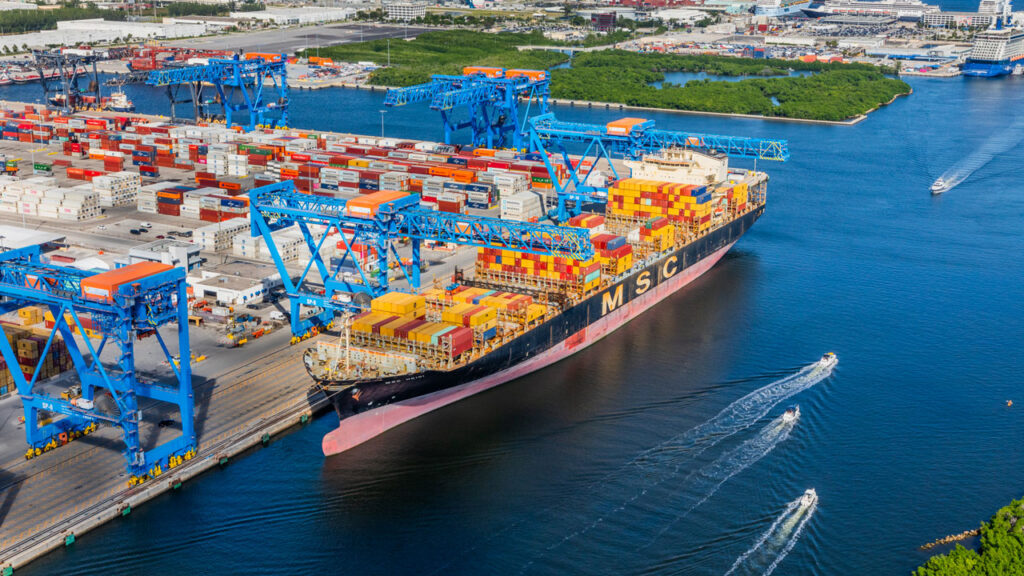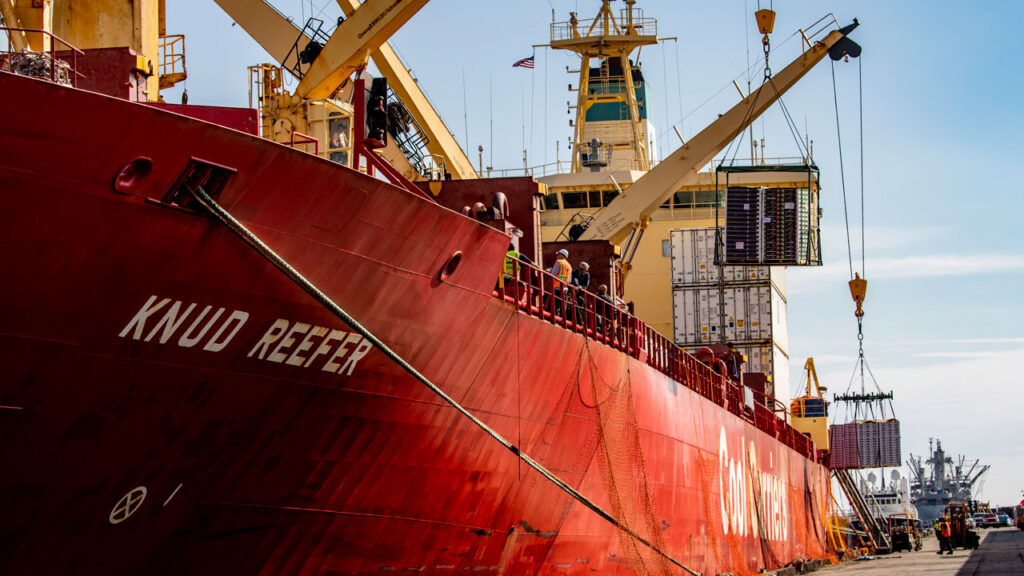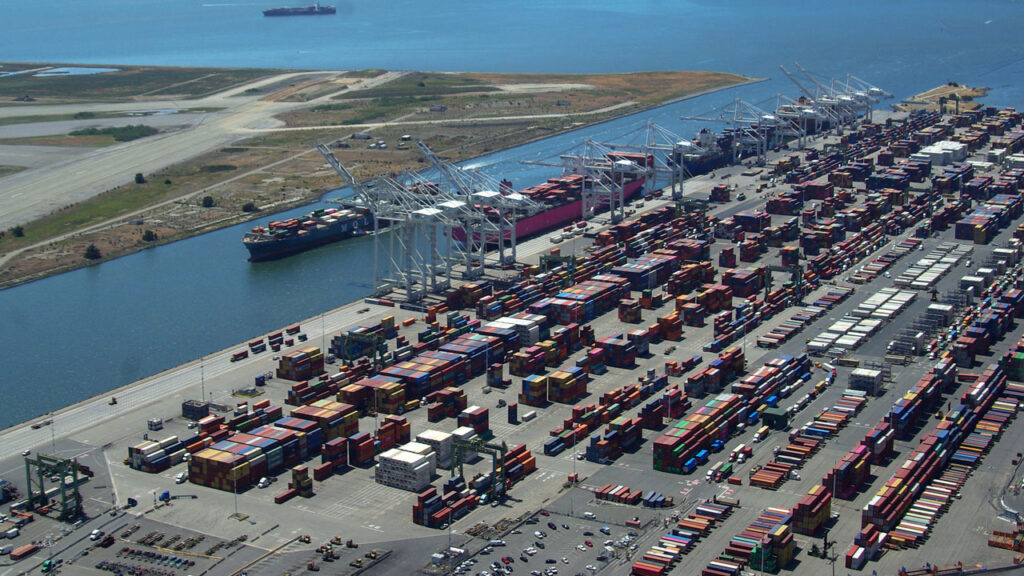Seaports Keep Fresh Produce Moving
October 30, 2025 | 11 min to read

US port representatives provide an update on operations and new developments.
From Florida to California, seaports play a pivotal role in keeping fresh produce moving efficiently through the global supply chain. Each port has its own strengths — from Port Everglades’ dominance in perishables and Port Wilmington’s banana imports, to Oakland’s gateway for California-grown exports and Hueneme’s cold chain innovation.
Collectively, these hubs not only connect growers to markets, but also drive billions in economic activity, support critical infrastructure upgrades, and adapt to shifting trade dynamics, tariffs and consumer demand.
PORT EVERGLADES
International trade makes Port Everglades an economic powerhouse for Broward County, FL, and one of the most diverse U.S. seaports, according to Robert Barceló, business development senior manager, Port Everglades.
Located in South Florida, Port Everglades is a leading container port in Florida and among the country’s most active cargo ports. The port is near the Atlantic Ocean shipping lanes, Florida East Coast railway, Florida’s highway system, the Fort Lauderdale-Hollywood International Airport and area beaches.
“The Port Everglades Department is a self-supporting enterprise fund of Broward County government,” says Barceló. “It doesn’t rely on local tax dollars for operations or capital improvements. It operates as a landlord, with its customers independently managing their operations.”
Port Everglades generates almost $28.1 billion in economic activity annually, according to a commissioned report for fiscal year 2024.
Cargo moving through the port can reach 70% of U.S. consumer markets within four days by rail.
Produce that moves through the port includes pineapples, watermelons, avocados, citrus, asparagus, blueberries, grapes and tropical fruits and tubers.
According to Barceló, Port Everglades is updating its Master/Vision Plan, which includes billions of dollars in capital investments to improve productivity for cargo, cruise and petroleum businesses.
The port’s largest project in recent history was recently completed: The $471 million Southport Turning Notch Extension project allows privately operated cargo terminals to move more cargo faster and service larger vessels by adding five berths and six Super Post-Panamax container gantry cranes.
“As for tariffs, the port is insulated but not immune,” says Joseph Morris, chief executive and port director of Port Everglades. “Port Everglades’ diversified trade portfolio has provided a buffer, and its cargo customers’ trade with China accounts for less than 2% of the overall volume.”
Morris adds, however, “The port remains attentive to broader shifts in global trade that could have secondary impacts on cargo flows.”
The port handles an average of more than 1 million Twenty Foot Equivalent Units (TEUs) annually and services 150 ports in 70 countries, Barceló says. Most of the trade is with Latin America and the Caribbean.
“Perishable cargo volumes exceeded 130,000 TEUs, placing Port Everglades as Florida’s No. 1 port for perishables,” says Barceló. “Nationally, we are ranked No. 8.”
As a landlord port, cold chain management is primarily handled by the privately operated terminals.
“One critical infrastructure upgrade underway is the replacement of the port’s bulkheads,” says Barceló. “The new bulkheads will enhance the structural integrity and safety of the berths for all marine vessels, as well as ensure that the bulkheads can adapt to projected sea level rise.”
The U.S. Army Corps of Engineers’ Harbor Navigation Improvement project, which is pending federal environmental approval, will deepen and widen the port’s navigational channels and turning basin to address safe shipping requirements as older fleets are being replaced with larger vessels.
PORT OF LOS ANGELES
In 2024, the Port of Los Angeles, CA, imported 44,792 TEUs and exported 11,914 TEUs of refrigerated (reefer) containers containing produce, according to Marcel van Dijk, port marketing manager.
“Although most container operations stack containers to optimize the terminal space, reefer containers are placed on a chassis and plugged into electric outlets to maintain the cold treatment,” explains van Dijk.
He adds that placing the reefer containers on chassis facilitates a fast turnaround time for the trucking companies that pick up and deliver the reefer containers.

The Port of Los Angeles has no cold storage facilities on port property, however, there are six large cold storage warehouses a few miles from the port complex that offer 116,500 pallet positions combined, says van Dijk.
“We provide a gateway for California-grown produce to consumers in Asia, Central and Latin America. With 22 individual shipping line services, the export community has a choice to ship their produce to overseas markets.”
PORT WILMINGTON
Port Wilmington, DE, is on 308 acres at the confluence of the Delaware and Christina rivers. This location is a major East Coast gateway, roughly equidistant from Washington, D.C. and New York City.
The port is run by Enstructure, a U.S. marine terminal and logistics company. According to an Enstructure spokesperson, this port has large-scale infrastructure and a diverse service offering of general cargo, perishables, containers, bulk, RoRo (roll-on/roll-off) and breakbulk products.
Port Wilmington is the No. 1 banana port in North America, serving as Dole Fresh Fruit Co. and Chiquita Fresh North America’s Mid-Atlantic distribution hub, according to Enstructure.
In addition to 270 tons of bananas, Port Wilmington typically receives over 16 million cases of fresh Chilean fruit annually, including Chilean table grapes, apricots, peaches, nectarines, plums, apples, pears, cherries, berries and other fruits. The port also handles Moroccan clementines, Argentine apples and pears, and Peruvian grapes and kiwifruit.
PORTMIAMI
PortMiami is under the Miami-Dade County, FL, umbrella. According to Alfredo “Freddy” Pereira, media and public relations manager, the county owns all of the land and leases out the cargo side of the business to three terminal operators. “One is Seaboard Marine, which brings in 46% of the cargo business; their main import is produce.”
The port recently completed a project that added 23 reefer plugs to its yard and also added more reefer plugs to the other two terminals.
PortMiami is big into cargo shipping and has made recent investments in the last decade to increase this number.
“We’re now producing more with less ships due to larger ships,” says Pereira. “Also, in 2014, we opened the tunnel so we have direct access to the city. This alleviates trucks from going downtown.”
This past July, PortMiami broke ground on a $140 million project, a sanitary warehouse with an airport.
“We can process produce to make it last longer without fumigation,” says Pereira. “This was thanks to funding from a grant through Congressman Mario Díaz-Balart, with the airport and seaport chipping in.”
He adds there is rail connectivity at the port, so the northern parts of the country can be reached in four days. Produce comes in via PortMiami’s cargo port and goes to South Florida distributors.
PORT OF CALDERA
The Port of Caldera in Costa Rica recently dealt with closures of more than five consecutive days due to high swells, severe port congestions, schedule disruptions, and, in some cases, labor strikes.
The weather events are getting more pronounced, says Raul Saca, senior vice president, Global Logistics, for the Port of Caldera. “For example, in Caldera, Costa Rica, the high swells would only affect the port two to three times a year. However, this year, we have already had around 10.”
As vessels have gotten larger and more cargo is moved, most ports and their capability to handle the additional volume have not grown, he adds.
“Over the years, the vessels have gotten bigger and the volume of cargo moving has increased, but the ports, for the most part, have remained the same,” Saca notes. “Lack of investment in port infrastructure will remain and all the problems that come with it — delays, extra costs, disrupted schedules, contingencies, etc.”
“Over the years, the vessels have gotten bigger and the volume of cargo moving has increased, but the ports, for the most part, have remained the same. Lack of investment in port infrastructure will remain and all the problems that come with it — delays, extra costs, disrupted schedules, contingencies, etc.”
— Raul Saca, Global Logistics, Port of Caldera
An efficient port that is not congested brings several advantages: minimizing costs, helping maintain a reasonable shelf life for perishable products, avoiding disruptions of the supply chain, and avoid damaging the port’s reputation as a reliable supplier, he says.
PORT OF OAKLAND
The Port of Oakland is California’s third busiest container port and a critical gateway for U.S. agricultural exports. It handles approximately 2.3 million TEUs annually.
“As a landlord port, we own the land and infrastructure, but lease terminals to private operators,” says Carolyn Almquist, manager of business development and international marketing. “We offer direct vessel service to Asia and other global markets, and our proximity to California’s Central Valley makes us a strategic hub for fresh produce exports.”
The port is currently undergoing infrastructure upgrades to support long-term growth and resiliency. These projects include completing fender and bollard improvements to safely accommodate larger vessels; expanding on-dock and near-dock cold chain capacity; and upgrading truck and rail access to support future inland intermodal development.

In addition to the infrastructure work, Port of Oakland is investing in digitization and data tools that provide real-time visibility for cargo owners — including fresh produce shippers who depend on accurate timelines.
For the produce sector, this means faster vessel turnaround, reduced wait times, and stronger service reliability, Almquist adds.
“Tariffs and global market shifts continue to impact sourcing and routing decisions, but we see growing interest from exporters seeking efficient, reliable gateways,” says Almquist. “The Port of Oakland is well-positioned to support these shifts, especially as shippers look to diversify supply chains.”
“Fresh produce represents a key segment of our refrigerated cargo, with strong export volumes of citrus, grapes, apples, lettuce, broccoli and stone fruit,” says Almquist. “On the import side, we regularly handle avocados, berries and tropical fruits, particularly from Latin America, Southeast Asia and Oceania.”
The strength of the port’s outbound cold chain market makes it viable for ocean carriers to reposition empty refrigerated containers into Oakland to meet demand.
“At Oakland, we’ve worked closely with terminal operators, cold storage providers, and USDA and CBP inspectors to streamline handling and reduce dwell times,” says Almquist. “We also have dedicated fumigation and inspection facilities on-terminal, and several on- and near-dock cold storage facilities that provide pre-cooling, consolidation and cross-docking.”
Oakland offers proximity to California’s produce-growing regions, with easy truck access and cost-effective rail connectivity.
“We also serve as the last port of call on most Transpacific services, which provides a key advantage for perishable exports: some of the shortest ocean transits to Asia,” says Almquist. “For example, produce shipped from Oakland can reach Japan in as little as 11 days, helping maintain freshness and shelf life.”
The port also has a strong community of cold chain providers, agricultural exporters and logistics partners, creating an ecosystem tailored to the needs of the fresh produce industry, she adds.
THE PORT OF HUENEME
The Port of Hueneme in Ventura County, CA, is situated between Los Angeles and Oakland in a fertile agricultural region.
“Unlike many other ports that are owned and operated by a municipality, we are led by a group of five elected harbor commissioners who are accountable to the voters,” says Stacy Lange, chief commercial officer. “We rank fifth in the nation for both refrigerated cargo and autos. We promote speed-to-market by servicing our customers through a network of off-port facilities. Shipments shuttle quickly from vessel to these off-port facilities for inspections, customs clearance, processing and delivery.”
The port currently has $205 million in active grant projects and has invested $122 million in green and environmental initiatives.
“Much of this funding is going toward port electrification and EV handling equipment in pursuit of our ambitious and industry-leading goal of achieving zero emissions status before the end of 2030,” Lange says. “We are adding reefer plugs and improving our data interoperability.”
After making a blueberry cold treatment pilot program permanent earlier this year, the Port of Hueneme is now the No. 1 West Coast port for blueberries on top of its No. 1 standing for bananas. “We handle more than 5 billion bananas and $18 billion in cargo each year,” says Lange.
Before the port’s cold treatment pilot, most blueberries entered the U.S. through Philadelphia, PA, where this service was offered.
“Now, we are importing Peruvian blueberries at the Port of Hueneme thanks to our cold chain expertise. This also has environmental implications, as trucks no longer emit diesel exhaust while trucking blueberries from Philadelphia to Los Angeles.”
— Stacy Lange, Port of Hueneme, Ventura County, CA
“Now, we are importing Peruvian blueberries at the Port of Hueneme, thanks to our cold chain expertise,” says Lange. “This also has environmental implications, as trucks no longer emit diesel exhaust while trucking blueberries from Philadelphia to Los Angeles.
“We are actively exploring ways to build on our cold chain expertise, seeking new growth opportunities in cold treatment, export services and others.”
By launching new workforce training programs and strengthening its capacity, Lange says the port can bring speed, value, and reliability to the fresh produce industry.
1 of 17 article in Produce Business October 2025

